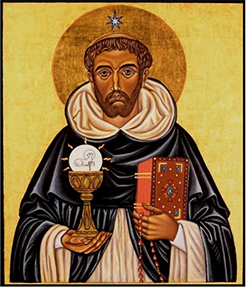St Dominic – 850th anniversary
Written by Dr. Paul Severn

For many saints, the day on which they are commemorated is the day on which they died, sometimes referred to as their ‘heavenly birthday’. This is only a rule of thumb and there are exceptions. In particular we celebrate the Birthday of the Blessed Virgin Mary (8 September) as well as her Assumption (15 August) and we celebrate the Birth of St John the Baptist (24 June) as well as his beheading (29 August). Also of note is the recently canonised St John Henry Newman who is kept on 9 October, neither the day of his birth nor his death, but the date on which he was received into full communion with the Roman Catholic Church (by Blessed Dominic Barberi in Oxford in 1845).
I say all this since this year we celebrate the eight hundred and fiftieth anniversary of the birth of St Dominic, in 1170, but we do not know the date of his birthday! By contrast we do know the date of St. Dominic’s death: 6 August (1221) and this was the date of St Dominic’s day in the ‘old calendar’ but it was transferred to 8 August in the calendar reforms following the Second Vatican Council. St Dominic’s influence is not insignificant on the Isle of Wight for there was a community of Dominican nuns at Carisbrooke Priory from 1866 until 1989 and there was a small community of lay Dominicans based at Weston Manor until very recently.
Briefly, St Dominic was born in 1170 at Caleruega in Spain. Encouraged by his parents and his uncle he studied at Palencia University, was ordained a priest and became a canon at Osma Cathedral. He was noted as a scholar, a man of prayer and for his engagement with the local people.
In 1203, and again in 1205, Diego de Azevedo, the bishop of Osma, embarked on European travels and he took Dominic with him. In part these were diplomatic journeys and in part they were preaching missions to combat the heresies that were then rife in France and elsewhere. Bishop Diego seems to have wanted to continue his preaching work but he was obliged to return to his diocese, so he established a house at Prouille in France and left Dominic in charge. Dominic drew a group of companions around him, forming a sort of mini-monastery and so 1206 is sometimes regarded as the beginning of the Order of Preachers, known colloquially as Dominicans.
But at this stage nothing was formal. In time, Dominic conceived of a body of men who would be well-educated specifically to preach and to combat heresy. In 1214 or 1215 the Papal Legate made Dominic the head of a preaching institute based in Toulouse and in 1215 his organisation received an ‘episcopal charter’ giving it some formal recognition. In late 1215 Dominic travelled to the Fourth Lateran Council and met Pope Innocent III. Dominic hoped that the Pope would confirm the ‘episcopal charter’.
But the Pope was hesitant to confirm Dominic’s preaching institute in Toulouse – not because he opposed it, but because he had in mind something much bigger! He suggested that Dominic and his companions should adopt a recognised rule, so they could turn their diocesan institute into a recognised Order which could spread without limit. In 1216 Dominic and his companions adopted the Rule of St Augustine (hence the cream Dominican habit – it’s their black cappa that gives the name Blackfriars) and this marked the formal beginning of the Order. This was confirmed on 22 December 1216 when Pope Honorius recognised the new order by his Bull: Religiosam Vitam.
The first Dominican Friars (they are not monks) arrived in England in 1221 and established houses in Oxford (1221), London (1223), Edinburgh (1230) and Cambridge (1238) and later in Newcastle (1239), Glasgow (1246) and Leicester (1247). These, of course, were all suppressed at the Protestant Reformation, but were re-founded at the beginning of the twentieth century. A panel above the main door of the Priory of the Holy Spirit in Oxford tells the visitor that the priory was re-founded in 1921, exactly seven hundred years to the day after the initial founding!

The Dominican emblem
What do we know of S Dominic’s character? Firstly, he was a humble man – three times he refused the invitation to become a bishop. He was undoubtedly a scholar but also a kindly man, who was renowned for spending long hours in public worship and private prayer. He was a captivating preacher, but in comparison to others at the time he believed in peaceful discussion, rather than threats! Blessed Jordan of Saxony, who succeeded Dominic, wrote that his master was friendly and joyful.
You can find examples of contemporary Dominican preaching and much else at the Godz Dogz website (www godzdogz.op.org) . Dominicans are sometimes affectionately known as Hounds of the Lord or Godz Dogz, since Domini Canes is Latin for the Dogs of the Lord.